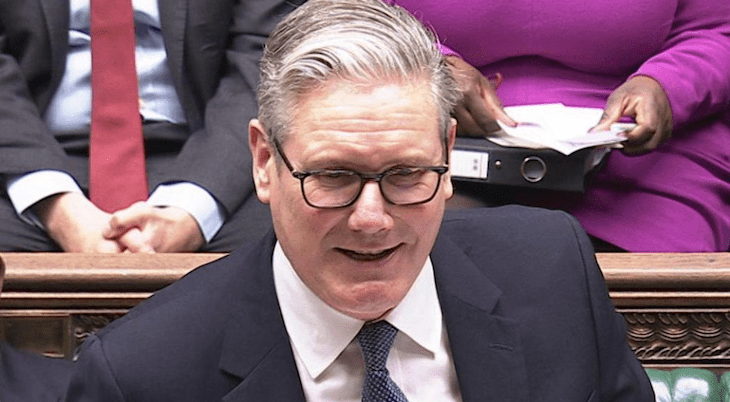Love them or loathe them, it’s hard not to have noticed Led By Donkeys. The protest group – made up, naturally, of four former Greenpeace workers – has taunted Boris Johnson, Liz Truss and David Cameron with its high-profile stunts. It is best known for projecting its protests – including one branding Boris a ‘liar’ – on to the Houses of Parliament. The group’s members seem mighty pleased with themselves. But what has Led by Donkeys actually achieved? It’s hard to say that the group has won anyone over to the cause.
The group’s members seem mighty pleased with themselves
An exhibition ‘Adventures in Art, Activism and Accountability’ has opened in Bristol to showcase the group’s exploits. It’s an underwhelming display. Led by Donkeys may have started out as a something of an anti-Brexit movement, but the photographs of those billboard capers were relegated to the narrow stairways that connected the rooms at the Midland Road exhibition space. Up front and central was the remote-controlled lettuce banner that disrupted Liz Truss’s speaking tour in August. ‘Returned by the police’, we were told.
The blue plaque that Donkeys erected outside 55 Tufton Street – ‘the UK economy was crashed here’ – was attached to a wall out the back at the exhibition space. While the organisers proudly claimed that ‘all the materials displayed were created at the time of the interventions, then either returned, reclaimed or never deployed’, there was little more to see that justified the long wait to enter the building.
The queue to get in stretched round the block – more than ninety people were standing there patiently on a warm and sunny Saturday afternoon in the Old Market district. Visit Bristol describes the area as ‘bohemian’. Worn out LGBTQ+ flags hung limply from angled flagpoles above our heads, while the occasional stench of cannabis polluted the air. The line was long because the building was small. The hi-vis woman on the door policed a strict one-in, one-out policy.
Wooden staircases connected the four rooms on four different levels. Just beyond the cabbage banner we were led down to the basement in groups of six to watch Donkeys’ film of thousands of items of children’s clothing laid out on Bournemouth beach to protest the conflict in Gaza. The stairs were steep, the lights were dim, and the smell of damp overpowering. Insulation boards hung haphazardly from the low ceiling, sandwiched between wooden beams at head bumping height.
Like the rest of the exhibition and, indeed, Donkeys’ work, the tiny cinema was an appeal to emotion. The movie was slick and professional, featuring 160 seconds of aerial footage. It was political propaganda of the highest order. On YouTube, the description reads, ‘Israel has killed over 11,500 Palestinian children in Gaza and the West Bank since October 7th, when 36 Israeli children were killed’. The tone made it seem like some kind of dismal competition.
However you might feel about Gaza – and it seemed that most of those who had braved the long wait and the plunge into the depth were happy to have their opinions reinforced – this was an effective piece of theatre. The same could not be said for the second film that was shown in the attic, featuring a number of high-profile politicians.
Donkeys were rather pleased with their 2023 sting when they tricked politicians, including Matt Hancock, into speaking to a fake South Korean investment company.
‘In the middle of a cost of living crisis, when people need their MPs more than ever, would a serving Member of Parliament still consider taking a job, furthering the interest of a foreign company?’, the exhibition filmed asked.
Of course some would. But while it might be embarrassing to be caught out, it’s not against the rules for an MP to do a bit of consultancy work as Hancock’s spokesperson pointed out at the time. Nor is it a secret; the Register of Members’ Financial Interests is on public record. So what was Donkeys trying to achieve?
This film was projected onto painted bricks in a room with lots of natural light. It was a pale imitation – quite literally – of Donkeys’ giant projection stunts when the sides of buildings are used as a canvas. But they require tens of thousands of lumens, and they take place after dark. Is this necessary?
This thought, it seemed, didn’t matter to the audience. As I squeezed down two flights of stairs to give up my place in the building to the next in line, the photos on the walls, the empty cans of paint, even a wheelbarrow used in one stunt, pieced together Donkey’s exasperation with the world as they saw it. There was much talk about accountability, but that was for others. The people who had to clear up the mess after Donkeys poured 360 litres of yellow and blue paint onto the road outside the Russian embassy on Bayswater Road were not mentioned in despatches.
A strong sense of self-righteousness permeates Donkeys’ work. I suspect that much of their time is spent preaching to the converted. The queue for the exhibition was long, the building was cramped, and the exhibition was limited, but how many minds were changed is harder to gauge.
The exhibition was a four-day affair – it has already come and gone – but the coffee table book that has been released to coincide with the display remains. You can well predict the type of people who are likely to buy it.
Led By Donkeys: Adventures in Art, Activism and Accountability is published by Thames and Hudson








Comments